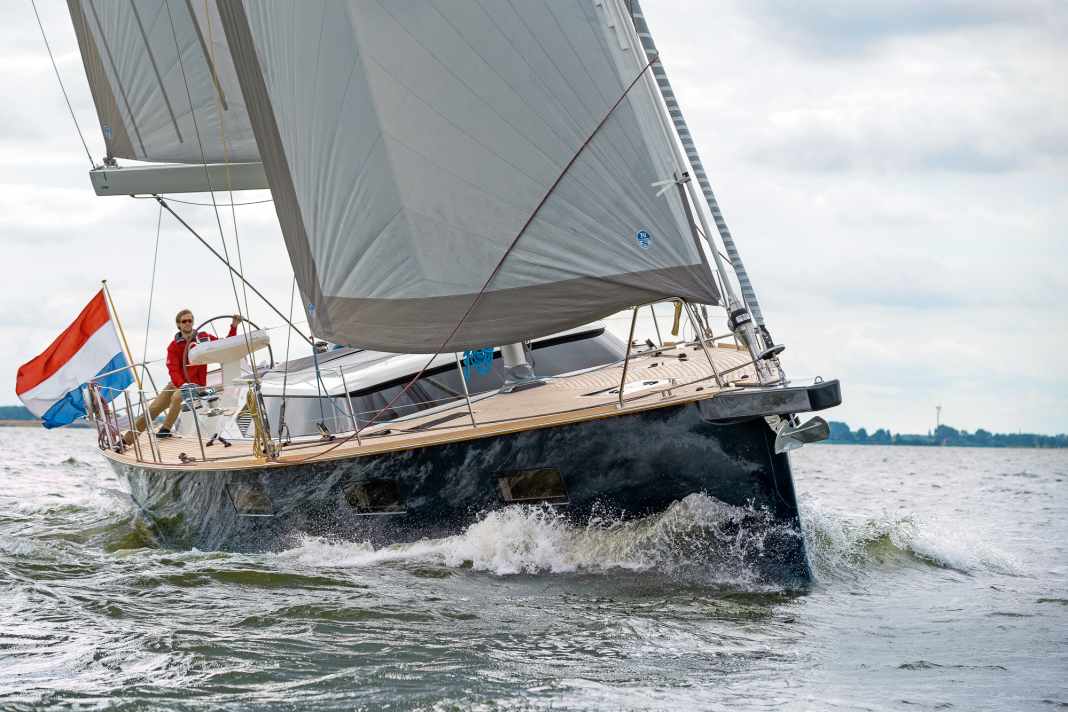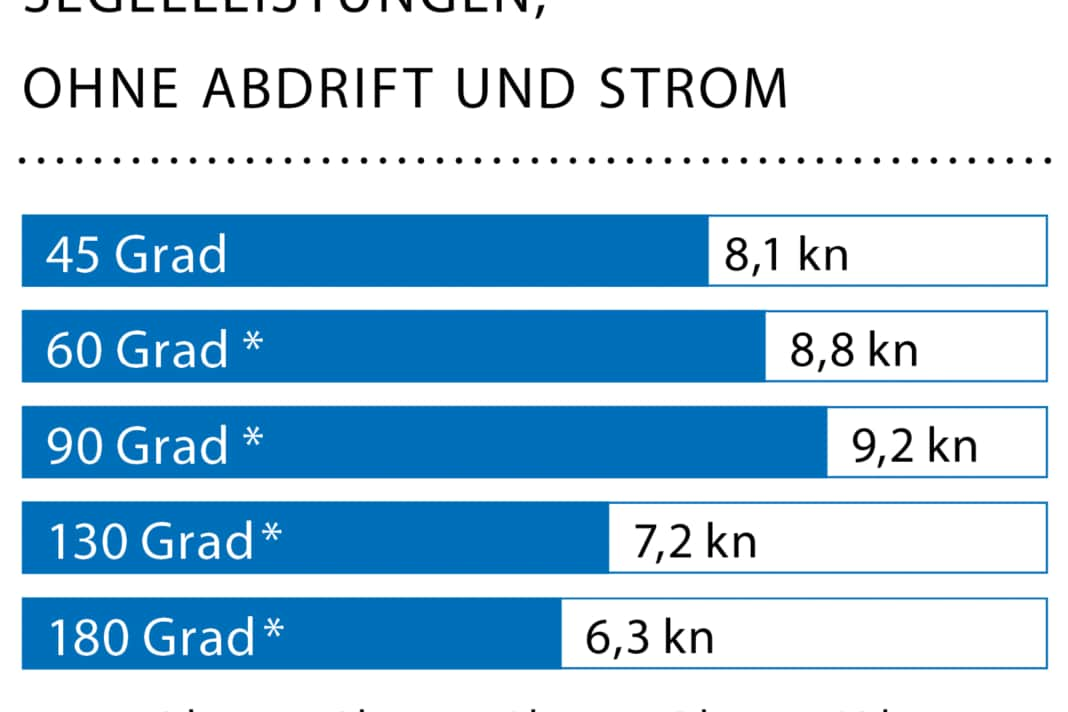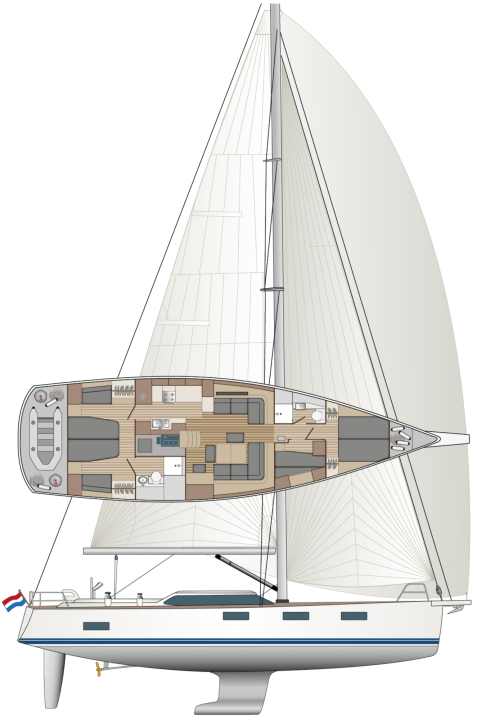





It was skipper Alessio Cannoni who got to the heart of the matter when testing the Contest 85 in 2019: "If a large sailing yacht doesn't sail well, then it's pointless. Then the owner is better off buying a motor yacht." Disarmingly simple and at the same time absolutely right.
Sailing has to be fun, otherwise an Elling E 6 or a representative of the English series shipyards à la Fairline or Princess will soon be on the wish list. But don't worry: this thought doesn't even come to mind with the Contest, not at all. Because the 55 is really fun. She is almost light on her feet, despite weighing 25 tonnes. It can be steered sensitively at the helm, gusts can be controlled with ease, the wind edge is found almost effortlessly. That's fine.
Also interesting:
The rudder pressure has been optimised for a boat of this design: sufficiently noticeable for self-steering sailors and largely trimmable for the autopilot. Among other things, the standard hydraulic power packs for the backstay and kicker help here. The designers at Judel/Vrolijk and Co. really did a great job with the planning, and the shipyard has created a stiff ship that transfers the power from the rig well into the water.
The tacking angle and upwind speed are perfectly fine at under 90 degrees and just under 8 knots on the log. At the same time, the wind was gusting at 4 to 5 Beaufort during the test. In addition, the fresh water of the IJsselmeer firstly provides less buoyancy, which increases the wetted area, and secondly is only a good four metres deep. There is only around one and a half metres of space under the keel, which weighs eight and a half tonnes. That also slows it down a little. The Contest doesn't seem to care. She sets off, especially when the Code Zero is rolled out. In gusts of around 20 knots, the log climbs to 12 knots with about half the wind. Of course, almost every boat sails well in such conditions.
Pleasure on the bike
However, the fascination lies less in the pure numbers than in the directness and precision with which the Dutchwoman can be steered. The water ripples, the gust comes, the boat lays slightly on its side, the pressure in the wheel increases slightly, and off she goes. It's reminiscent of the times on the BM dinghy or the Valk. Except that here, 17 metres in length and five metres wide on deck, it's impressive.
The good thing about the size is the poise with which the Contest goes about its work. Even when the edge of the deck pulls through the water - which is not easy given the enormous height of the freeboard - everything remains under control; there is no hint of a sun shot. Of course, the reefing limit has long since been reached when the boat is heeling so strongly. A few pushes of the button later, and the big one thanks the now reduced sail area with noticeably less lay, less pressure and ultimately more speed.
And while the harbour is usually approached under engine towards the end of the test and the tester crawls below deck to measure everything and anything, off Medemblik they cruise back to the harbour. Of course, electric genoa winches or the central mainsheet, whose own winch also has a button, help here. But that's not the point. Rather, it is simply the fun that the Contest provides at the helm. The paradox between comfort and sailing pleasure seems to have been resolved. Chapeau. Motor yacht? No, not a thought.
Of course, the sail load of 4.4 is not generous, and if the wind blows at 8 knots instead of 18 knots, the Contest will certainly have a harder time; after all, it is around seven tonnes heavier than the Solaris 55 of the same size, although the Swan and Oyster of the same size have a similar weight.
However, this is not noticeable on the test day due to the sufficient wind. Thanks to the electric and hydraulic aids, the sailing work is easy to handle and quickly completed. The boat is also ideal for a short fun trip after work. And if you don't want to go home afterwards, the Contest offers the comfort of home.
Live more beautifully
A few examples: Standing heights of over two metres throughout, the bed in the owner's cabin measures 1.80 by 2.00 metres, the showers are also large enough at 70 by 80 centimetres to allow you to freshen up without compromising on comfort. Of course, that's what you expect from a ship like this. However, the consistent realisation and the focus on real usability, without distracting corners and edges, show the shipyard's experience with the little things. And they simply make the new boat easy to live on. Even at sea: handrails, leeward sails, handles - everything is there, but discreetly hidden in the design.
The standard version has six fixed berths, two of which are in a bunk bed. The interior design options are initially limited, but the shipyard is prepared to fulfil customer wishes wherever possible. And then there are the many pleasing details. Firstly the woodwork: Not a single screw can be seen in the interior. All the handrails and mouldings are also made in one piece, elaborate but extremely durable. The grain runs through, no hectic breaks are visible. All gaps fit, all seams are aligned. Of course, you have to appreciate things like this to accept the slightly longer price tag on the Contest.
Great attention to detail
Other examples? As many hoses leading outboard as possible are routed to a standpipe in the engine room, which reduces the number of required onboard passages. The ones that are still there are made of brass and are all earthed to a zinc anode to prevent galvanic wear.
The sound and vibration insulation of the engine compartment is so good that you really don't notice the engine in the cockpit, neither in the form of noise nor vibrations underfoot. The fuel filter system is easily accessible behind a kitchen cabinet. This allows you to quickly switch to the second filter - at extra cost - if the first one becomes clogged. The generator has its own filter. Naturally, they are all equipped with a water alarm. The tank itself has a pump at the lowest point so that any water that collects there can be easily removed.
There are plenty of details like this on the Contest. This makes it an easy-to-use blue water cruiser that also scores points for its good sailing characteristics. At Contest, top build quality is a family affair. The third generation is no slouch in this respect either. Sure, for the price of the Contest you get four Hanse 548s from the same designer. But that's the subtle difference.
The measured values for testing the Contest 55 CS




The Contest 55 CS in detail

Technical data of the Contest 55 CS
- Designer: Judel/Vrolijk & Co
- CE design category: A
- Torso length: 17,00 m
- Width: 5,02 m
- Depth: 2,55 m
- Weight: 24,9 t
- Ballast/proportion: 8,4 t/34 %
- Mainsail: 92,8 m2
- Furling genoa (106 %): 71,0 m2
- machine (Volvo Penta): 110 kW/150 hp
Hull and deck construction
Hull and deck vacuum infusion, foam core, solid laminate over keel, GRP strongback, laminated bulkheads
Price and shipyard
- Base price ex shipyard: 2,258,620 € gross incl. 19% VAT.
- Guarantee/against osmosis: 2/5 years
As of 08/2024, how the prices shown are defined can be found here!
Shipyard
Contest Yachts BV in Medemblik, www.contestyachts.com. Sales are handled by the shipyard
YACHT review of the Contest 55 CS
A blue water cruiser par excellence, with a tidy look and amazingly agile sailing characteristics. At the same time, it has the typical contest finish and sensible details. All this makes the boat quite expensive
Design and concept
- + Elaborate design
- + Tidy deck
- - Low bridge deck
Sailing performance and trim
- + Trim sensitive
- + Agile sailing
Living and finishing quality
- + Exquisite woodwork
- + Large berth dimensions
- - Water hoses behind switch panel
Equipment and technology
- + Emergency system switch
- + Very elaborate sound insulation
- - Double filter only at extra cost
The article first appeared in YACHT issue 20/2020 and has been revised for this online version.

